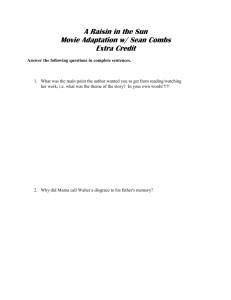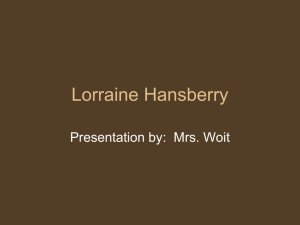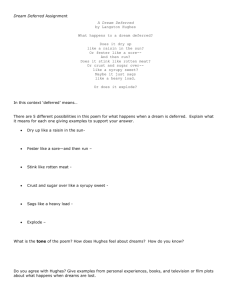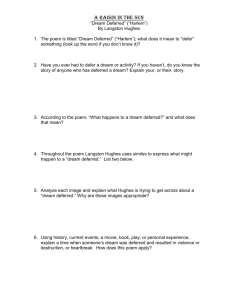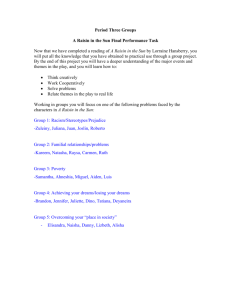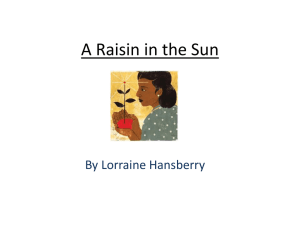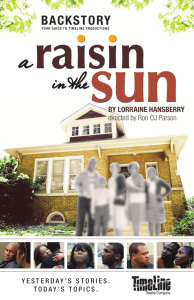“Harlem (Dream Deferred)”
advertisement
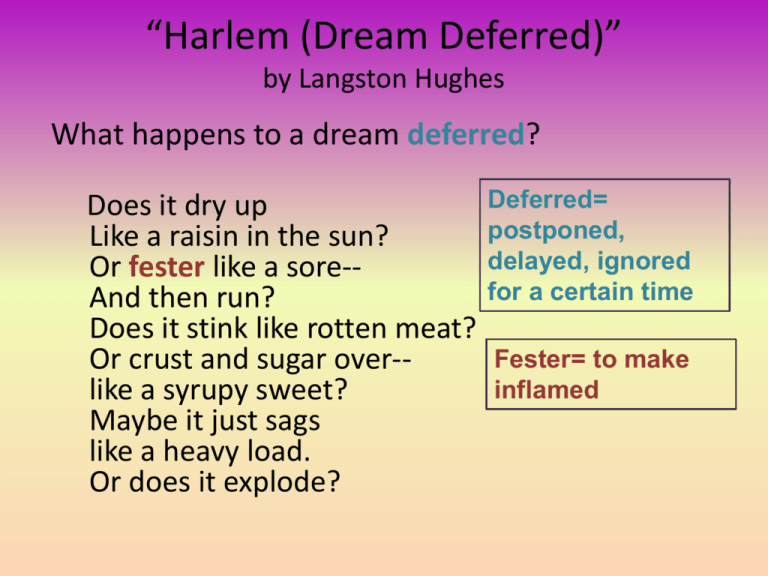
“Harlem (Dream Deferred)” by Langston Hughes What happens to a dream deferred? Deferred= Does it dry up postponed, Like a raisin in the sun? delayed, ignored Or fester like a sore-for a certain time And then run? Does it stink like rotten meat? Fester= to make Or crust and sugar over-inflamed like a syrupy sweet? Maybe it just sags like a heavy load. Or does it explode? “Harlem (Dream Deferred)” by Langston Hughes What happens to a dream deferred? 1 2 3 4 5 6 Deferred= Does it dry up postponed, Like a raisin in the sun? delayed, ignored Or fester like a sore-for a certain time And then run? Does it stink like rotten meat? Fester= to make Or crust and sugar over-inflamed like a syrupy sweet? Maybe it just sags like a heavy load. Or does it explode? Your Group’s Task 1. Visual representing your line from the poem 2. Imagery (language that appeals to the senses) What senses does your line appeal to: sight, sound, taste, touch, smell? 4. Theme (Hughes’ message?) 3. Mood (How does the imagery evoke certain feelings for the reader and what feelings?) Does it disappear like a shadow in the night? 1. 2. Imagery: This line appeals to the sense of sight (“shadow”) 4. Theme (Hughes’ message?) A dream deferred can be easily lost 3. Mood “shadow disappearing” It evokes a hopeless, gloomy feeling in the reader. Themes A “Dream Deferred”… • Can be lost quickly/Can vanish as easily as they come • Can become a burden • Can fade away • Can make you feel stress, regret Agenda 11/14/12 • Raisin Background (Civil Rights Movement) • Hand out Packets • Begin Reading Act 1, Scene 1 • • • • • Walter Ruth Travis Beneatha Mama Introduction to Lorraine Hansberry’s A Raisin in the Sun The story • Written in 1957 and produced in 1959. • The play depicts the dreams and struggles of one black family living in a small apartment on the south side of Chicago during the 1950s. Civil Rights Movement… (~1955-1968) Racism and Segregation Black School in Virginia First Rock Elementary School for black children -- the main building shown on the right was used for grades 1,4-5. Had pupil capacity of 120; When more room was needed, the small frame building on the left was built. It was covered with roofing paper, had no windows, no steam/water heat and no indoor plumbing. White School in Virginia Darlington Heights Elementary School for white children. Pupil capacity was 200; used for grades 1-7; But, an addition to the structure was built in 1937, to accommodate more students. The school had steam and hot water heat and indoor plumbing. Brown vs. Board of Education • 1954 Supreme Court decision that reversed Plessy (separate but equal) by stating that separate schools are by nature unequal. • Schools are ordered to desegregate "with all deliberate speed" Sept. 8, 1954 Fort Myer Elementary School in Fort Myer, Va. …However, the desegregation of schools didn’t begin to take effect until 1957. …AND the case’s decision did not abolish segregation in other public areas, such as restaurants and restrooms. ...Which still left room for more discrimination. African Americans faced discrimination in housing: White people living in certain neighborhoods all agreed not to sell their homes to African Americans. President Johnson signs the Civil Rights Act of 1968, prohibiting discrimination in the sale, rental, and financing of housing. Hansberry’s fight against discrimination: • Hansberry’s writing was inspired by her own personal experiences. • In 1940, her family was involved in a legal battle against racially segregated housing laws in the Washington Park Subdivision of the South Side of Chicago during Hansberry’s childhood. Chicago Tenement Tenement= a run down and often overcrowded apartment house, especially in a poor section of a large city. • The layout of these apartments was all legal. Landlords were allowed to create any different apartments out of one big apartment. In addition from making many small compact "apartments" out of one large apartment, landlords also charged a large amount of money for them. • A white person would actually pay much less for a large apartment, while African Americans had to pay almost double the amount for a small room. African Americans had no other choice but to live in these places because no other places were available for them. Whites made it illegal for African Americans move into their specific area, it was called redlining... Redlining... • The practice of denying, or increasing the cost of services such as banking, insurance, access to jobs, access to health care, or even supermarkets to residents in certain, often racially determined, areas. • The term "redlining" describes the practice of marking a red line on a map to delineate the area where banks would not invest • During the peak of redlining, the areas most frequently discriminated against were black inner city neighborhoods. For example, in Atlanta, through at least the 1980s, this practice meant that banks would often lend to lower-income whites but not to middle- or upper-income blacks. Banks created maps to show which neighborhoods they would not give home loans to Institutional Racism… • …describes societal patterns that have the net effect of imposing oppressive or otherwise negative conditions against identifiable groups on the basis of race or ethnicity. • In the United States, institutional racism results from the social caste system that was sustained by, slavery and racial segregation.
